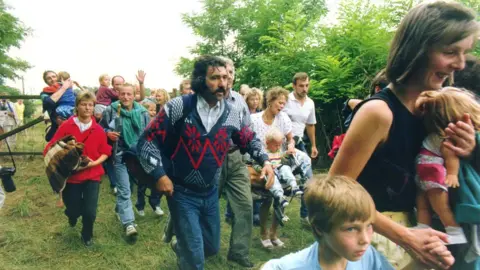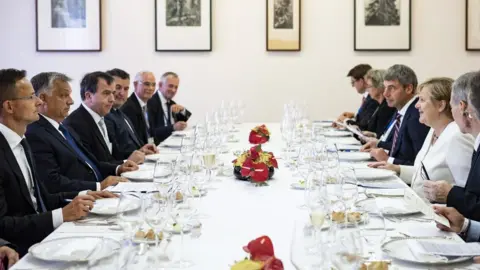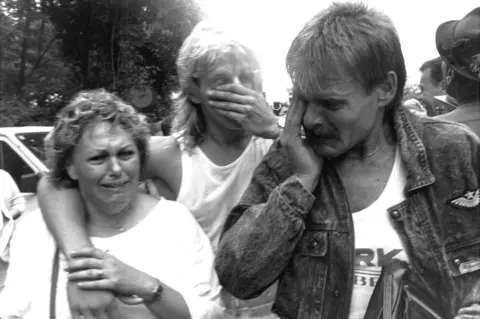'Cut the Iron Curtain': Germany's 1989 freedom picnic
 VOTAVA
VOTAVAAn innocent-sounding "Pan-European Picnic" in Hungary 30 years ago made the first rip in the Iron Curtain, when more than 600 East Germans rushed through a border gate into Austria.
It was the signal for an exodus to the West which became a flood, culminating in the fall of the Berlin Wall in November 1989, as pro-Soviet regimes collapsed one by one in central and eastern Europe.
German Chancellor Angela Merkel visited Sopron in western Hungary on Monday and expressed thanks for the Hungarian border guards' restraint, which - by allowing people to cross - contributed to German reunification a year later.
"Sopron is an example of what we Europeans can achieve when we stand up courageously for our indivisible values," she said in the town's Protestant church. "The picnic turned into a major world event."
The month before the picnic, the foreign ministers of Hungary and Austria had symbolically snipped the border fence, the physical "Iron Curtain" between the West and the communist bloc controlled by the Soviet Union.
East Germans were at the time kept under tight surveillance, with very little opportunity to travel. Mrs Merkel grew up in East Germany - an experience that turned her into a committed champion of liberal democracy.
The picnic was organised as a gesture of European unity, and the idea was to let Austrian and Hungarian delegations cross the border for a few hours - but it turned into an East German stampede westwards.
Allow X content?

Mrs Merkel and Hungarian Prime Minister Viktor Orban marked the 30th anniversary with lunch and a news conference in Sopron.
A veteran of the anti-communist struggle himself, Mr Orban has clashed with Mrs Merkel and the EU over human rights and asylum policy.
A reporter pointed out that he was celebrating the dismantling of a border fence - yet had erected a new border fence to keep migrants out.
He denied any contradiction, saying "the new ones are built precisely in order to preserve European peace and security".
 European Photopress Agency
European Photopress AgencyMeanwhile people who attended the picnic have been remembering the experience.
Ditte Preznanszky, a student in Budapest in 1989, was at a student camp for the summer, at the end of which she knew there would be a trip to the border, to "cut the Iron Curtain".
Ditte, whose family was divided by the Curtain, says the aim of cutting the fence was "to represent free Europe", and she thought of her grandmother, who had been born in Hungary before World War One, when it was "free".
In 1956 a revolt by Hungarians opposed to hardline Soviet communism was crushed by Soviet tanks, sending many Hungarians fleeing to the West, including some of Ditte's relatives, who ended up in the UK.
"Cutting the Curtain was very symbolic: To be free, to open up," said Ditte. "I kept the piece of fence I cut for 20 years."
'Eyes full of tears'
At the age of 46, Werner Misch travelled to the picnic from Halle in East Germany.
He did not, however, cross into Austria with the crowd, because he had frail parents to look after.
Now 77, he reminisced about the experience, interviewed by German broadcaster Deutschlandfunk.
"There were people with eyes full of tears, others cheered and embraced each other.
"I couldn't grasp it - the fact that they were opening the border there. It's amazing what Hungary did then. I'm grateful to them for opening that border, which enabled subsequent events to take place."
He kept a piece of the border fence as a souvenir.
 Getty Images
Getty Images'Suspicion can't be switched off'
Jörg Meissner, another former East German citizen, told Spiegel news website he had heard about the picnic plan about six weeks before, but was suspicious.
"I travelled alone, to minimise the risk of being caught," he said. He kept meeting other East Germans on holiday who appeared to have the same plan to flee.
"At the beginning we avoided speaking openly. The GDR had taught us to be suspicious."
Jörg had a tent and bike, so he could make a quick dash across the border to freedom.
When the gate opened he was among the first through. He didn't cry, as "it was all too unreal for me".
He worried about what would happen to his family back in the GDR.
The East Germans were put on a bus, which took them to Vienna. "The initial celebrations had died down. People were quiet, deep in thought. Suspicion can't be easily switched off," he said.
